
Description
In response to Bangladesh’s Country Investment Plan for agriculture, food security, and nutrition, the USAID-funded Policy Research and Strategy Support Program (PRSSP) provided demand-driven food- and agricultural-policy research since 2010, focusing on seven key areas:
- Agricultural growth and climate change
- Fishery development and livestock sectors
- Gender
- Governance
- Marketing and regional and global trade
- Nutrition
- Social safety nets
The PRSSP generated information on critical issues, strengthened analytical capacity within the country, and stimulated policy dialogue. Its main objectives were to enhance the efficiency of food production and marketing, accelerate income growth of the poor, and improve nutrition for vulnerable groups.
For more information, please contact the former PRSSP Chief of Party and Country Representative for Bangladesh Akhter Ahmed.
PRSSP: Project Detail
STATUS: Completed
DURATION: 2010-2020
FUNDING: United States Agency for International Development (USAID)
PARTNER(S): UN World Food Programme (WFP); Data Analysis and Technical Assistance (DATA); Bangladesh Ministry of Agriculture
IFPRI Bangladesh Projects
IFPRI has over four decades of experience conducting research and outreach in Bangladesh. IFPRI has undertaken rigorous evaluations using randomized controlled trials of several programs in Bangladesh, including Alive & Thrive, IFPRI-WFP’s Transfer Modality Research Initiative (TMRI), and the IFPRI-designed and Ministry-led Agriculture, Nutrition, and Gender Linkages (ANGeL) project. IFPRI has also designed and conducted large-scale household surveys like the Bangladesh Integrated Household Survey and has proven capacity to administer rapid yet rigorous phone surveys amid the pandemic.
RELATED PUBLICATIONS
1 to
20
of 100
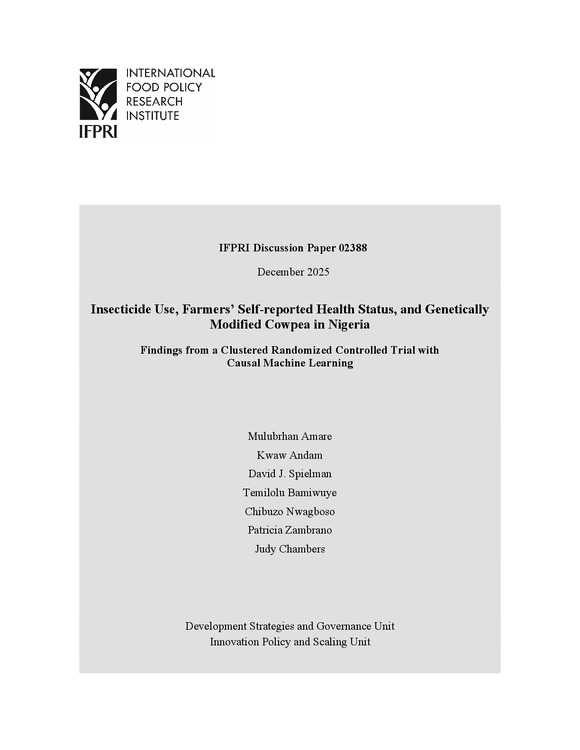
Working Paper
Insecticide use, farmers’ self-reported health status, and genetically modified cowpea in Nigeria: Findings from a clustered randomized controlled trial with causal
2025Amare, Mulubrhan; Andam, Kwaw S.; Spielman, David J.; Bamiwuye, Temilolu; Nwagboso, Chibuzo; Zambrano, Patricia; Chambers, Judith A.
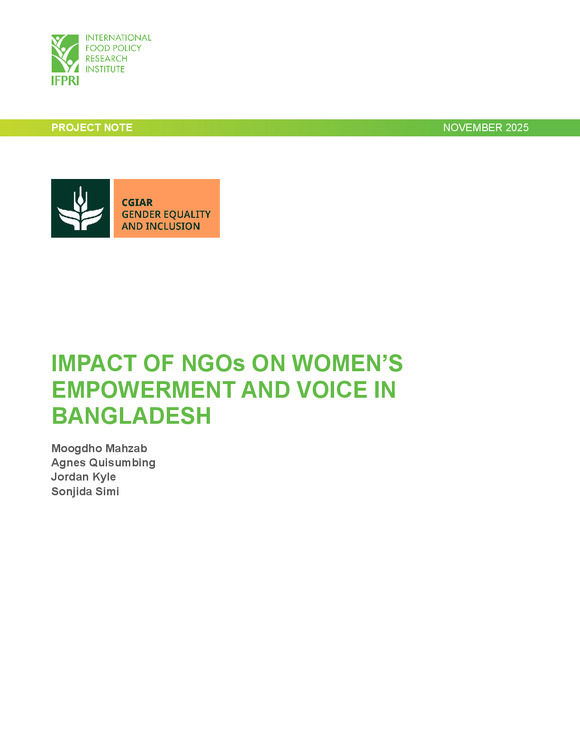
Brief
Impact of NGOs on women's empowerment and voice in Bangladesh
2025Mahzab, Moogdho; Quisumbing, Agnes R.; Kyle, Jordan; Simi, Sonjida Mesket
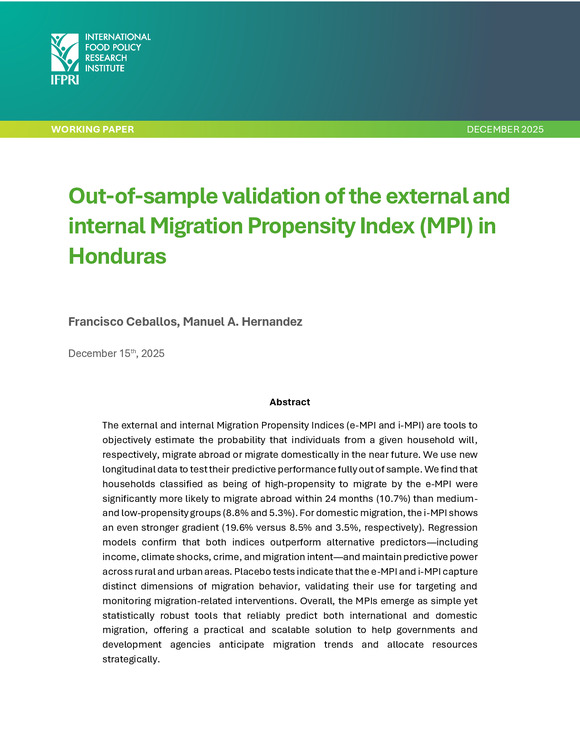
Working Paper
Out-of-sample validation of the external and internal Migration Propensity Index (MPI) in Honduras
2025Ceballos, Francisco; Hernandez, Manuel A.

Working Paper
Perceived need and measured well-being: How well do subjective rankings capture relative poverty?
2025Ranucci, Immacolata; Abay, Kibrom A.; Tiberti, Luca

Working Paper
Targeting of beneficiaries in chemical fertilizer subsidy programs: State of knowledge and evidence gaps
2025Trachtman, Carly; Hill, Ruth Vargas
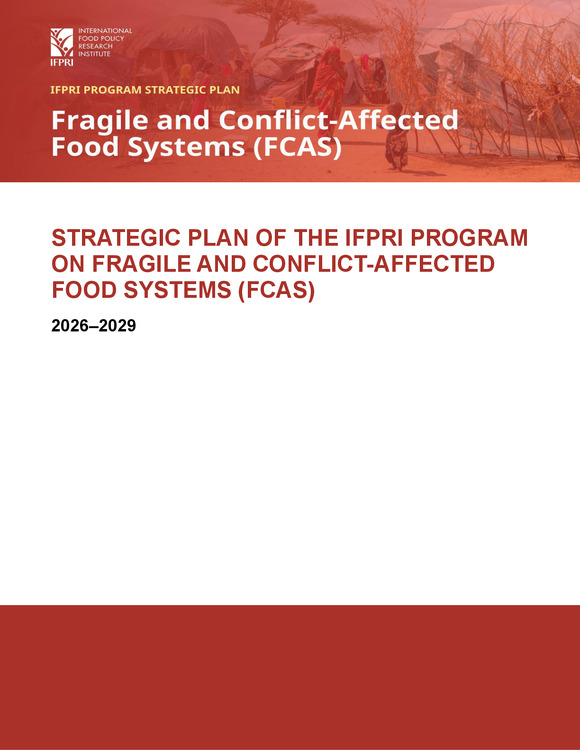
Internal Document
Strategic plan of the IFPRI program on fragile and conflict-affected food systems (FCAS): 2026-2029
2025International Food Policy Research Institute
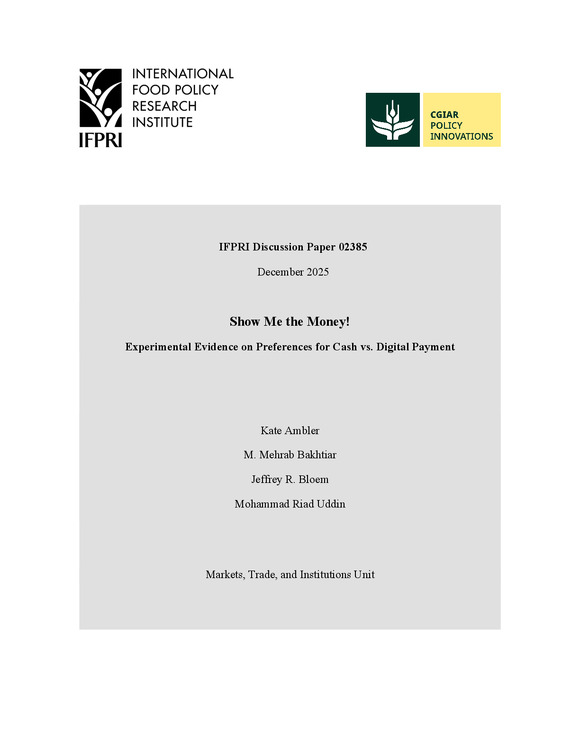
Working Paper
Show me the money! Experimental evidence on preferences for cash vs. digital payment
2025Ambler, Kate; Bakhtiar, M. Mehrab; Bloem, Jeffrey R.; Uddin, Mohammad Riad
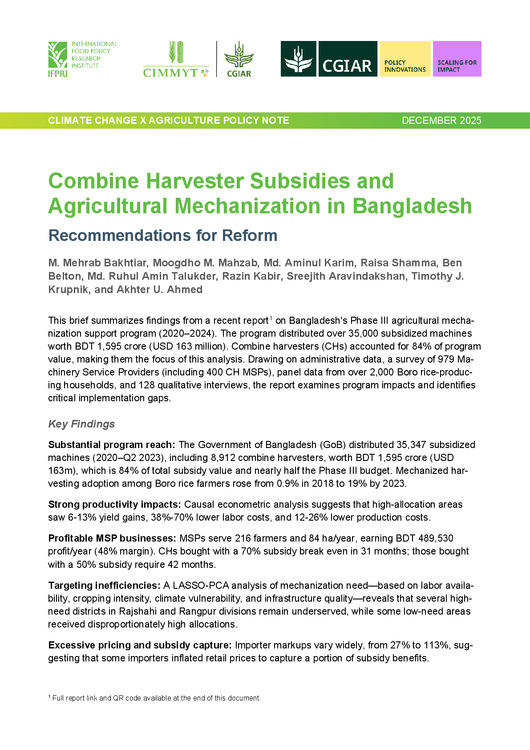
Brief
Combine harvester subsidies and agricultural mechanization in Bangladesh: Recommendations for reform
2025Bakhtiar, M. Mehrab; Mahzab, Moogdho; Karim, Md. Aminul; Shamma, Raisa; Belton, Ben; Talukder, Md. Ruhul Amin; Kabir, Razin; Aravindakshan, Sreejith; Krupnik, Timothy J.; Ahmed, Akhter
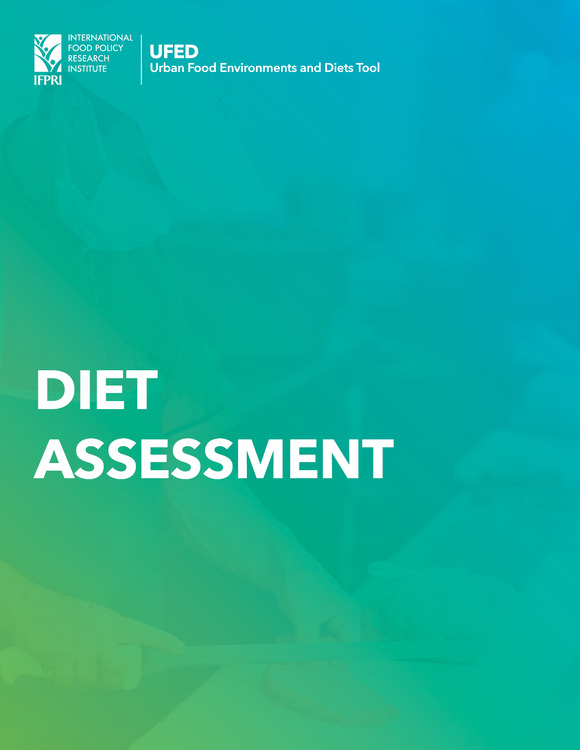
Training Material
Urban Food Environments and Diets (UFED) dietary assessment guidance
2025International Food Policy Research Institute
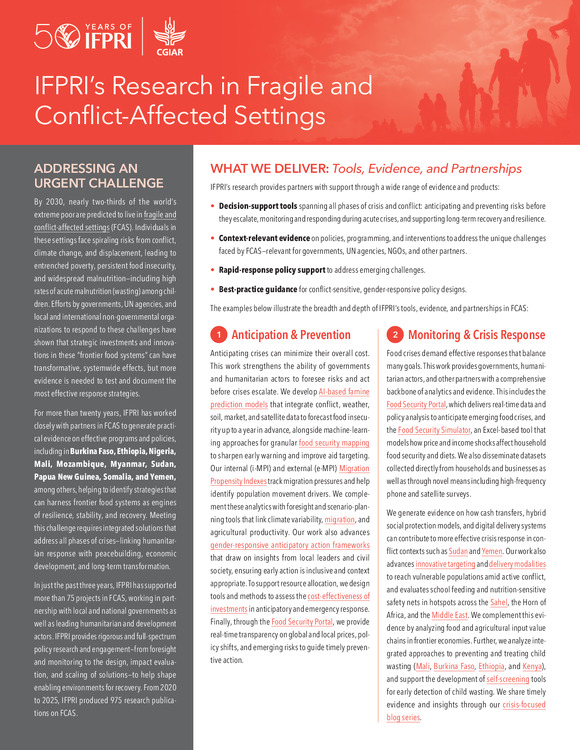
Brochure
IFPRI’s research in fragile and conflict-affected settings
2025International Food Policy Research Institute
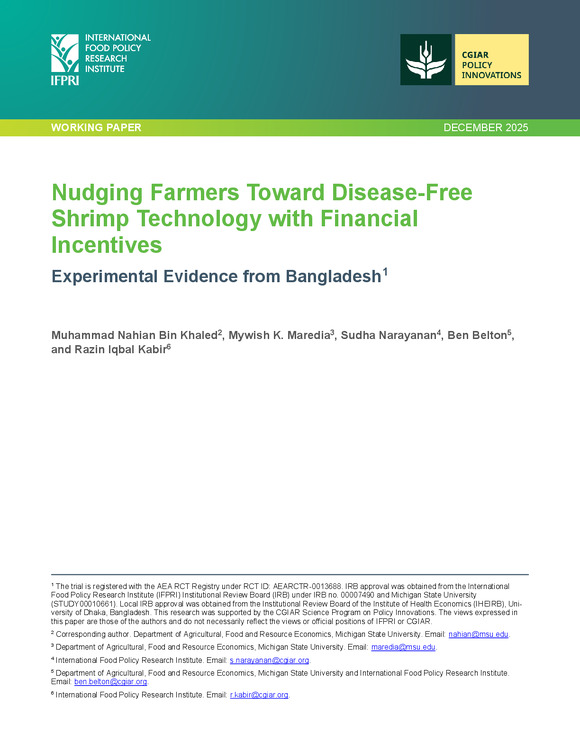
Working Paper
Nudging farmers toward disease-free shrimp technology with financial incentives: Experimental evidence from Bangladesh
2025Bin Khaled, Muhammad Nahian; Maredia, Mywish K.; Narayanan, Sudha; Belton, Ben; Kabir, Razin
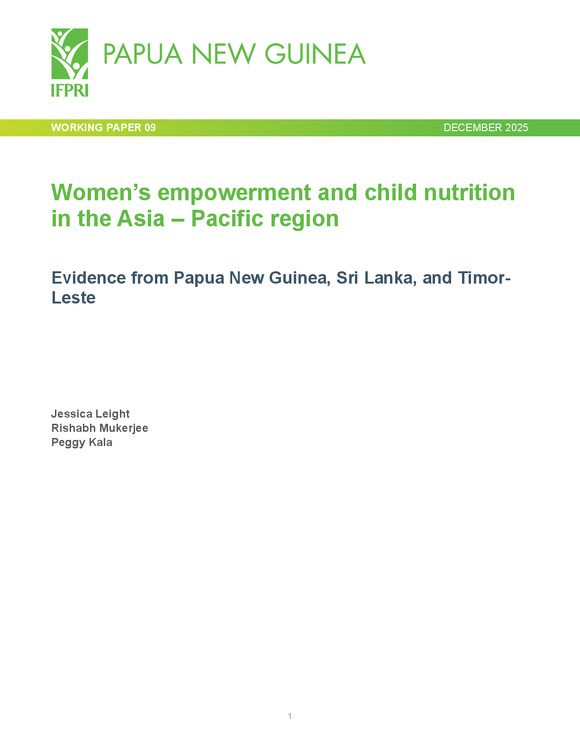
Working Paper
Women’s empowerment and child nutrition in the Asia – Pacific region: Evidence from Papua New Guinea, Sri Lanka, and Timor-Leste
2025Leight, Jessica; Mukerjee, Rishabh; Kala, Peggy

Data Paper
2023 Social Accounting Matrix for Bangladesh: A Nexus Project SAM
2025International Food Policy Research Institute; South Asian Network on Economic Modeling

Brief
Gendered work norms in Egypt: Evidence on preferences and social perceptions
2025Allen IV, James; Gilligan, Daniel O.; Kurdi, Sikandra; Shokry, Nada; Yassa, Basma
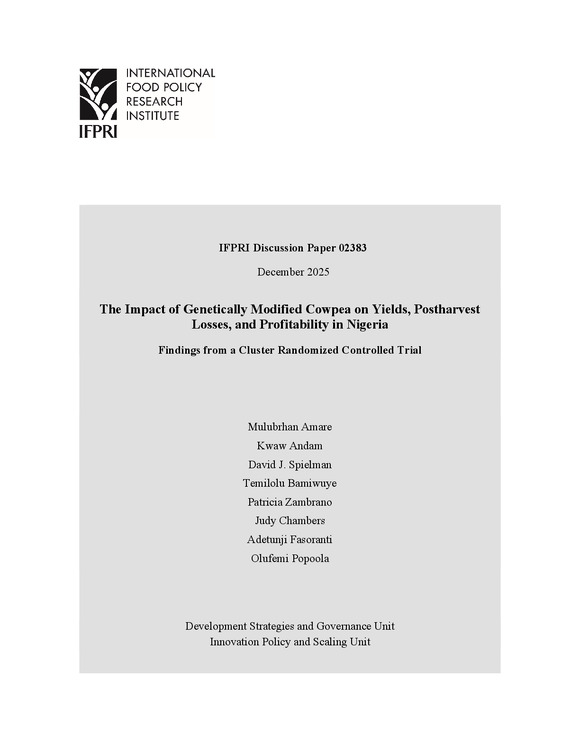
Working Paper
The impact of genetically modified cowpea on yields, postharvest losses, and profitability in Nigeria: Findings from a cluster randomized controlled trial
2025Amare, Mulubrhan; Andam, Kwaw S.; Spielman, David J.; Bamiwuye, Temilolu; Zambrano, Patricia; Chambers, Judith A.; Fasoranti, Adetunji; Popoola, Olufemi
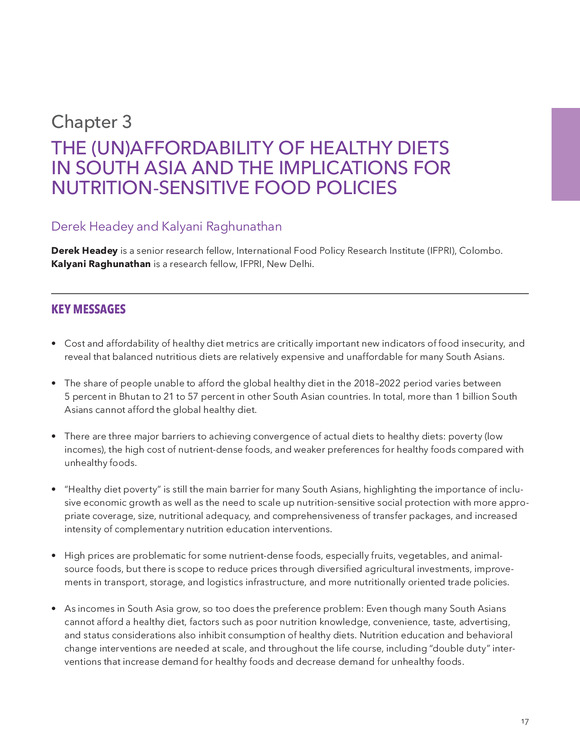
Book Chapter
The (un)affordability of healthy diets in South Asia and the implications for nutrition-sensitive food policies
2025Headey, Derek D.; Raghunathan, Kalyani
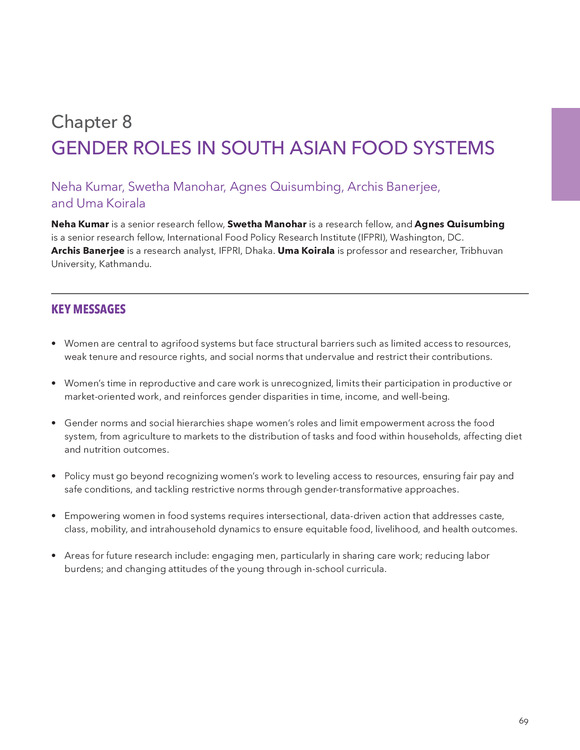
Book Chapter
Gender roles in South Asian food systems
2025Kumar, Neha; Manohar, Swetha; Quisumbing, Agnes R.; Banerjee, Archis; Koirala, Uma
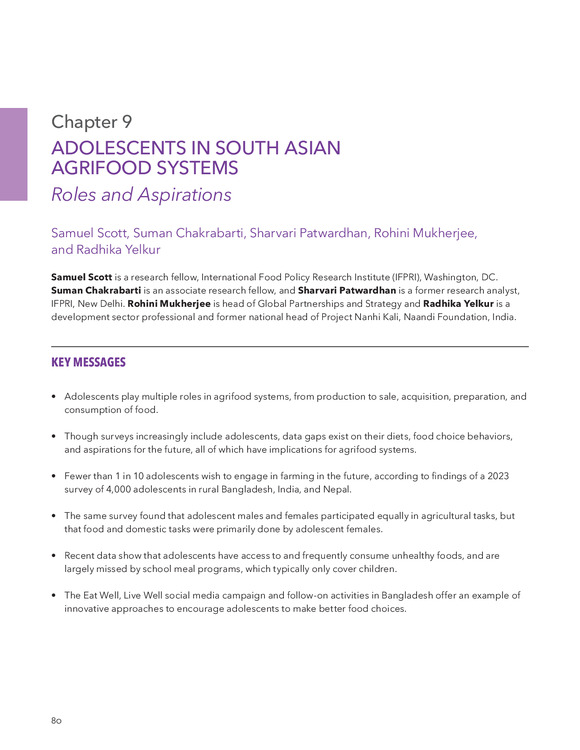
Book Chapter
Adolescents in South Asian agrifood systems: Roles and aspirations
2025Scott, Samuel P.; Chakrabarti, Suman; Patwardhan, Sharvaro; Mukherjee, Rohini; Yelkur, Radhika

Book Chapter
Food environments and behavioral drivers of food choice in South Asia
2025Chakrabarti, Suman; Chauhan, Alka; Patwardhan, Sharvari; Joe, William
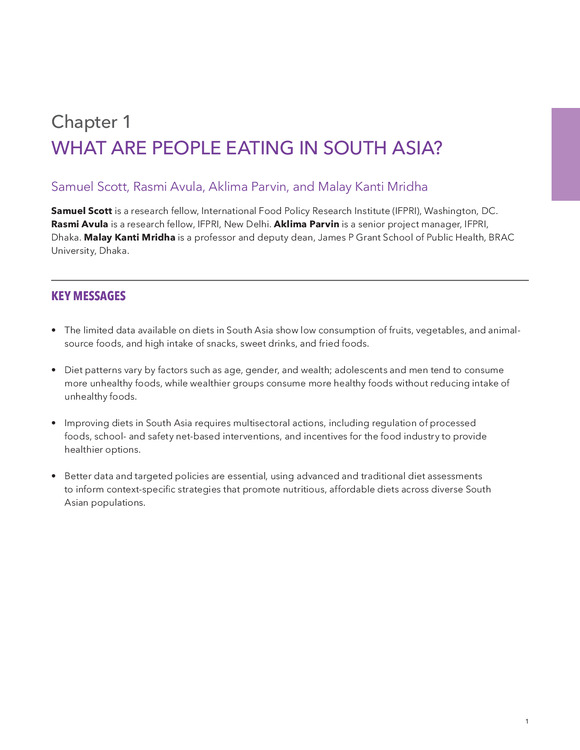
Book Chapter
What are people eating in South Asia?
2025Scott, Samuel P.; Avula, Rasmi; Parvin, Aklima; Mrindha, Malay Kanti

Book Chapter
Social safety nets for a nutrition-sensitive food system in South Asia: Lessons from India
2025Rahman, Andaleeb
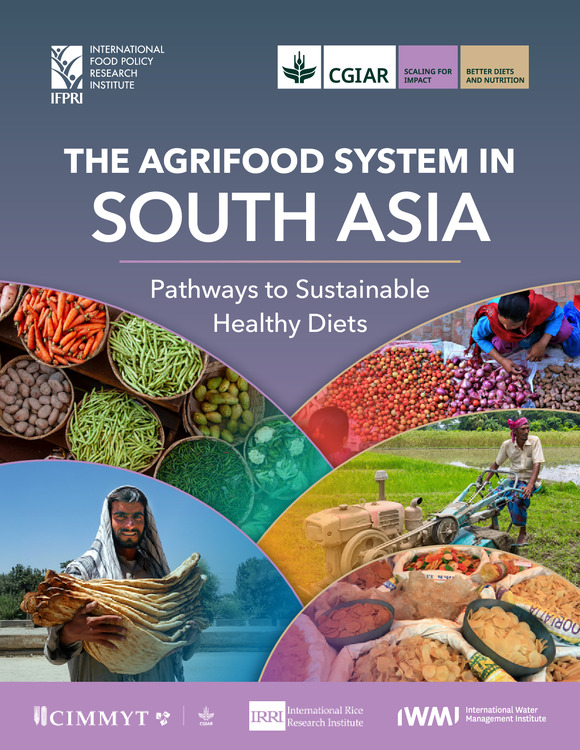
Book
The agrifood system in South Asia: Pathways to sustainable healthy diets
2025International Food Policy Research Institute; Scott, Samuel P.; Kishore, Avinash; Headey, Derek D.
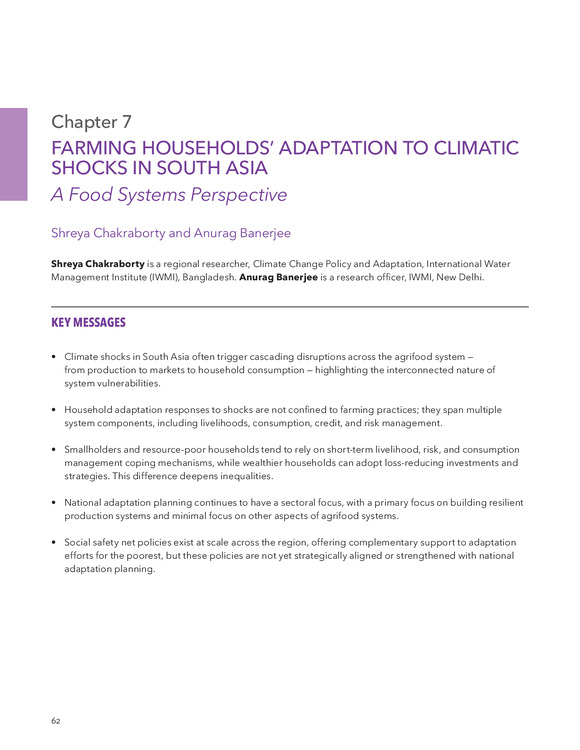
Book Chapter
Farming households' adaptation to climatic shocks in South Asia: A food systems perspective
2025Chakraborty, Shreya; Banerjee, Anurag

Book Chapter
Overview - Agrifood systems transformation in South Asia: An agenda for impact and learning at scale
2025Menon, Purnima; Krupnik, Timothy J.

Book Chapter
More land, more diverse diets? Exploring production and consumption trade-offs in the eastern Indo-Gangetic plains
2025
...more
Sayem, Md Abu; Gathala, Mahesh; Krupnik, Timothy J.
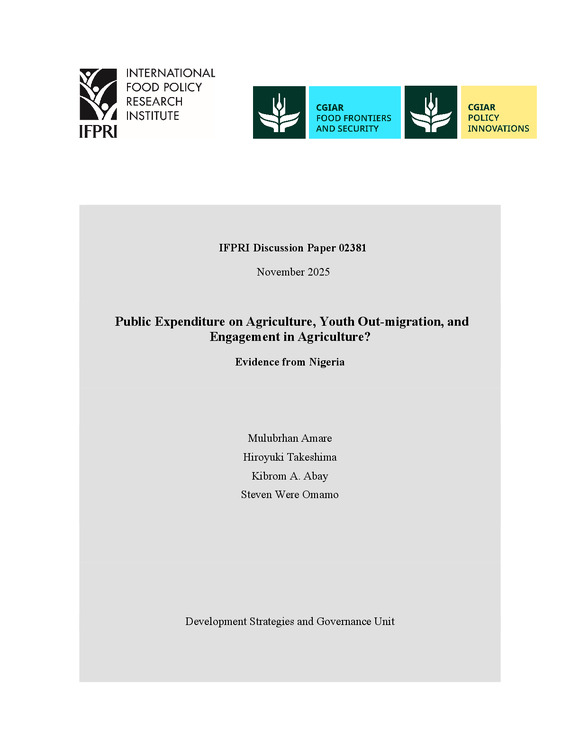
Working Paper
Public expenditure on agriculture, youth out-migration, and engagement in agriculture? Evidence from Nigeria
2025Amare, Mulubrhan; Takeshima, Hiroyuki; Abay, Kibrom A.; Omamo, Steven Were

Working Paper
Rewriting the rules: How U.S. tariff paths could reshape global trade
2025Piñeiro, Valeria; Gianatiempo, Juan Pablo; Rueda, Jorge Armando; Glauber, Joseph W.

Brief
Nutrition and dietary quality in Sri Lanka: Insights from the 2024-2025 BRIGHT survey
2025
...more
Sabai, Moe; Stifel, Elizabeth; van Asselt, Joanna; Weerasinghe, Krishani
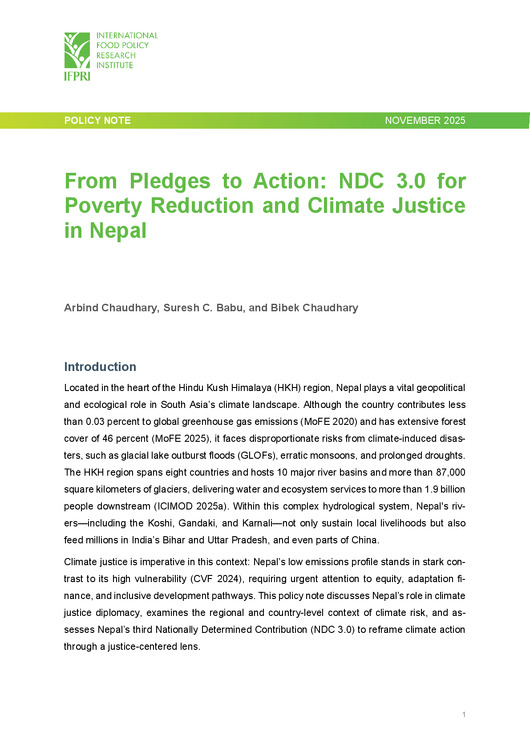
Brief
From pledges to action: NDC 3.0 for poverty reduction and climate justice in Nepal
2025Chaudhary, Arbind; Babu, Suresh Chandra; Chaudhary, Bibek
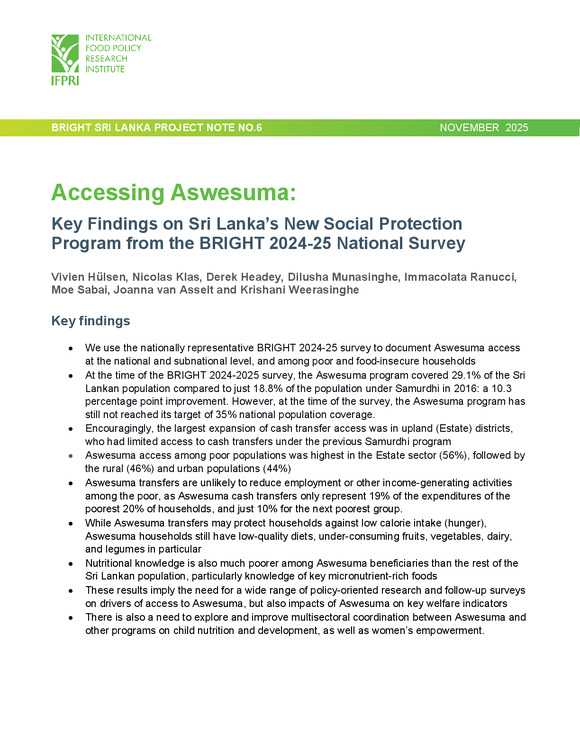
Brief
Accessing Aswesuma: Key findings on Sri Lanka’s new social protection program from the bright 2024-25 national survey
2025Hülsen, Vivien; Klas, Nicolas; Headey, Derek D.; Munasinghe, Dilusha; Ranucci, Immacolata; Sabai, Moe; van Asselt, Joanna; Weerasinghe, Krishani
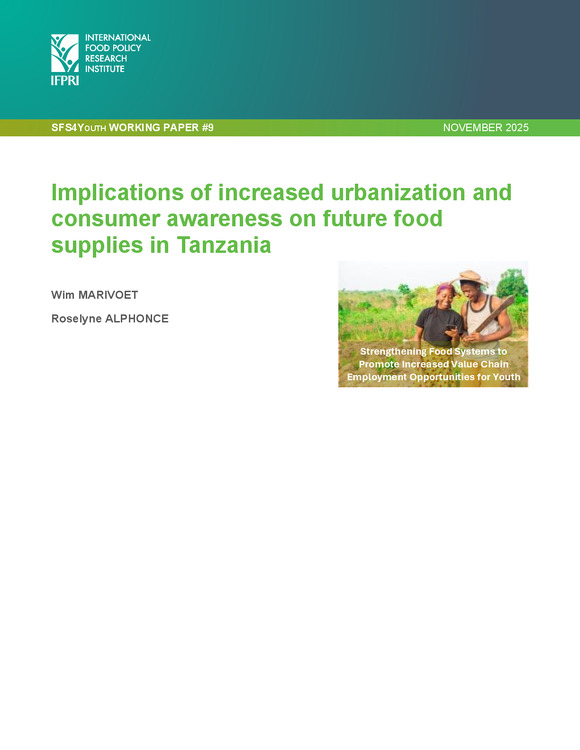
Working Paper
Implications of increased urbanization and consumer awareness on future food supplies in Tanzania
2025Marivoet, Wim; Alphonce, Roselyne
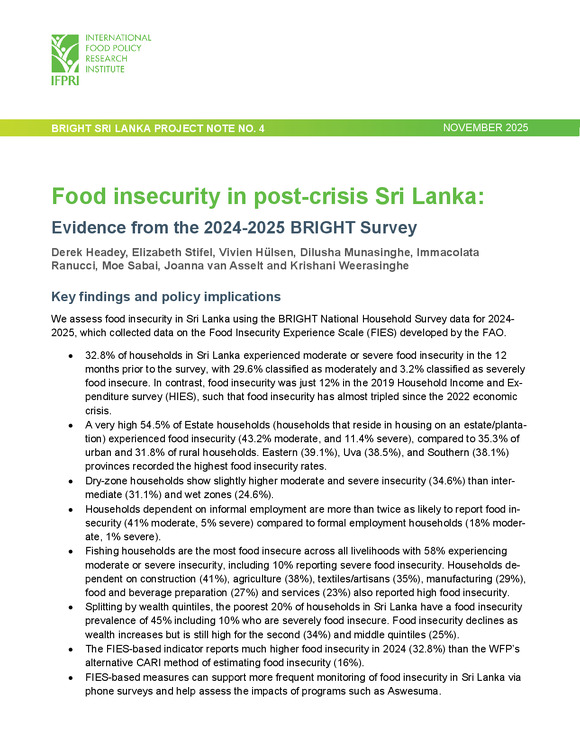
Brief
Food insecurity in post-crisis Sri Lanka: Evidence from the 2024-2025 BRIGHT survey
2025Headey, Derek D.; Stifel, Elizabeth; Hülsen, Vivien; Munasinghe, Dilusha; Ranucci, Immacolata; Sabai, Moe; van Asselt, Joanna; Weerasinghe, Krishani

Brief
Climate shocks and climate smart agricultural adoption in Sri Lanka, 2024-2025
2025van Asselt, Joanna; Weerasinghe, Krishani; Munasinghe, Dilusha; Hemachandra, Dilini
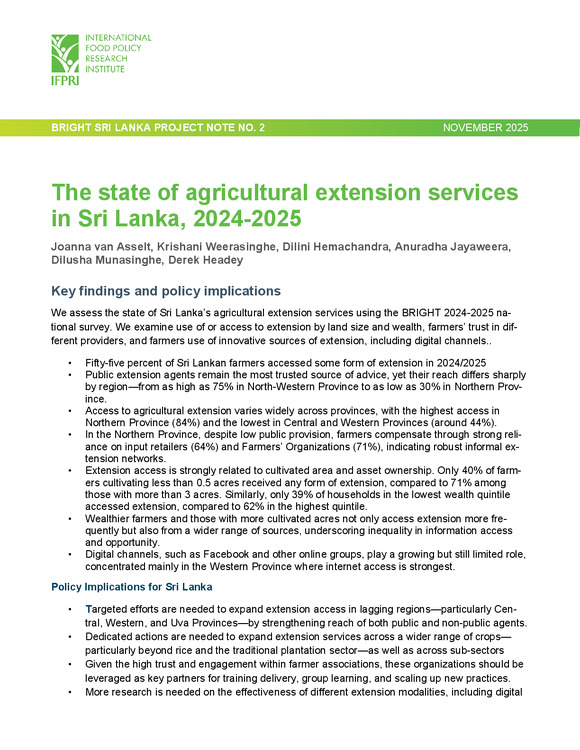
Brief
The state of agricultural extension services in Sri Lanka, 2024-2025
2025van Asselt, Joanna; Weerasinghe, Krishani; Hemachandra, Delini; Jayaweera, Anuradha; Munasinghe, Dilusha; Headey, Derek D.
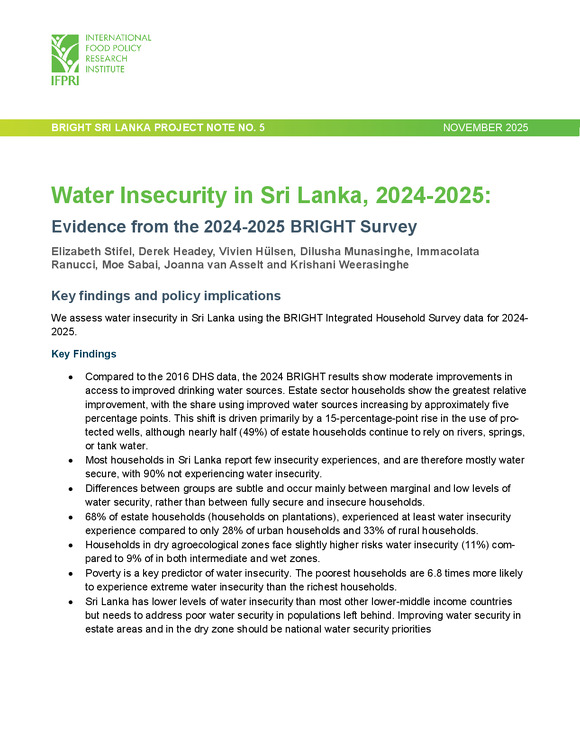
Brief
Water insecurity in Sri Lanka, 2024-2025: Evidence from the 2024-2025 BRIGHT survey
2025Stifel, Elizabeth; Headey, Derek D.; Hülsen, Vivien; Munasinghe, Dilusha; Ranucci, Immacolata; Sabai, Moe; van Asselt, Joanna; Weerasinghe, Krishani
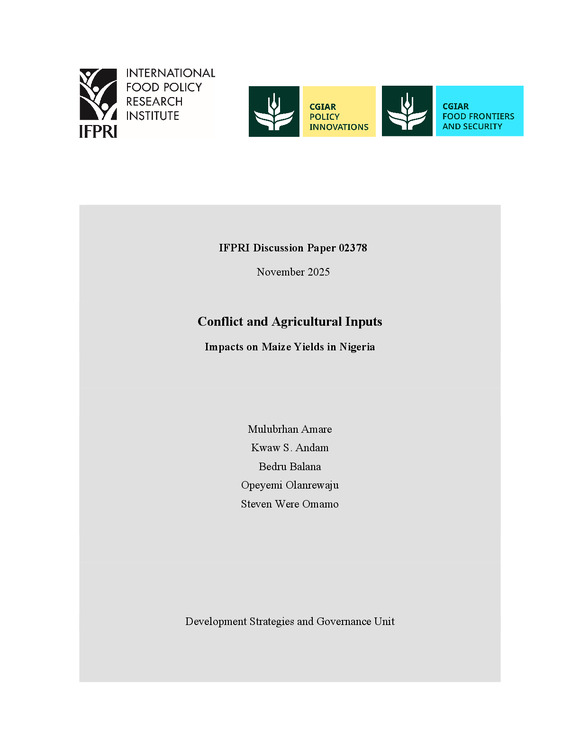
Working Paper
Conflict and agricultural inputs: Impacts on maize yields in Nigeria
2025Amare, Mulubrhan; Andam, Kwaw S.; Balana, Bedru; Olanrewaju, Opeyemi; Omamo, Steven Were

Working Paper
Gender, nutrition-sensitive agricultural interventions, and resilience: Evidence from rural Bangladesh
2025Hoddinott, John F.; Ahmed, Akhter; Bakhtiar, M. Mehrab; Quisumbing, Agnes R.
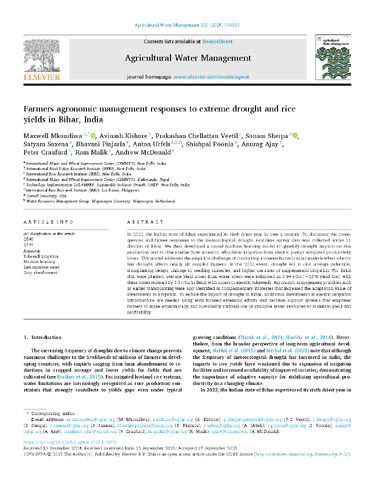
Journal Article
Farmers agronomic management responses to extreme drought and rice yields in Bihar, India
2025
...more
Malik, Ram; McDonald, Andrew
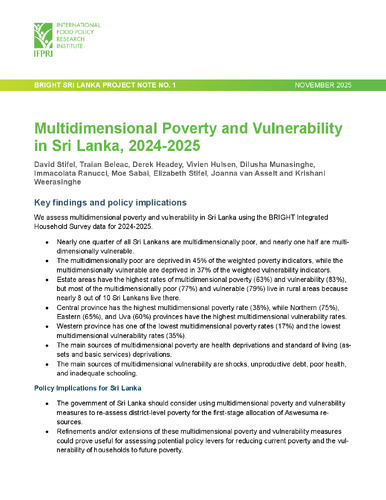
Brief
Multidimensional poverty and vulnerability in Sri Lanka, 2024-2025
2025Stifel, David; Beleac, Traian; Headey, Derek D.; Hülsen, Vivien; Munasinghe, Dilusha; Ranucci, Immacolata; Sabai, Moe; Stifel, Elizabeth; van Asselt, Joanna; Weerasinghe, Krishani

Working Paper
Signaling, screening, or sunk costs? Experimental evidence on how prices affect agricultural technology adoption in East Africa
2025Van Campenhout, Bjorn; Abate, Gashaw T.; Colen, Liesbeth; Kramer, Berber
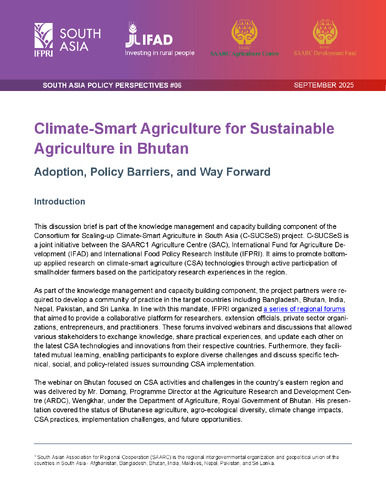
Brief
Climate-smart agriculture for sustainable agriculture in Bhutan: Adoption, policy barriers, and way forward
2025Pathak, Himanshu
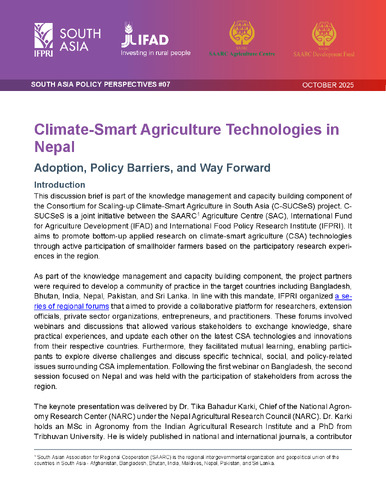
Brief
Climate-smart agriculture technologies in Nepal: Adoption, policy barriers, and way forward
2025Pathak, Himanshu

Brief
Climate-smart agriculture in Bangladesh: Adoption, policy barriers and way forward
2025Pathak, Himanshu
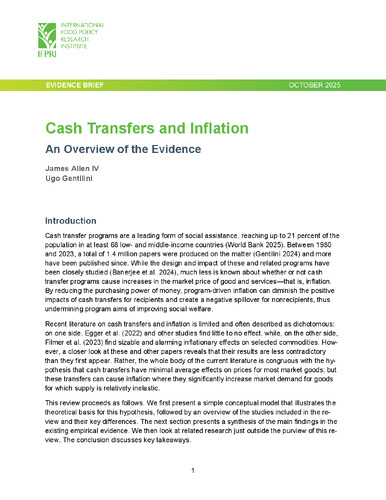
Brief
Cash, food, and vouchers: An overview of the evidence
2025Leight, Jessica; Gentilini, Ugo
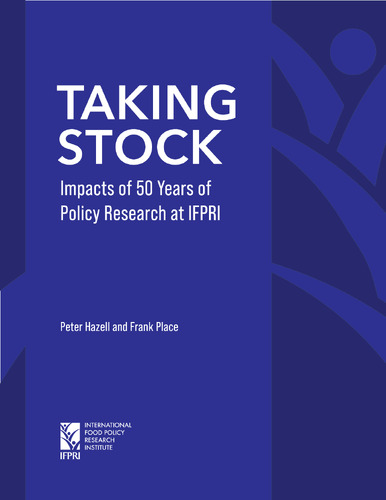
Report
Taking stock: Impacts of 50 years of policy research at IFPRI
2025Hazell, Peter B. R.; Place, Frank
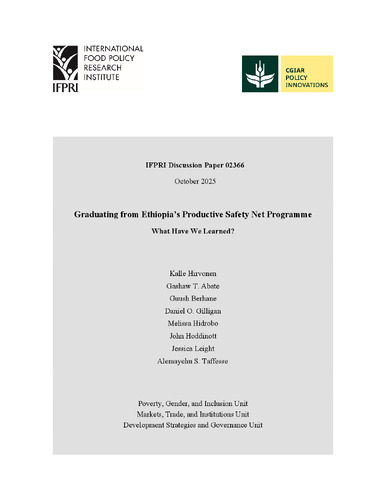
Working Paper
Graduating from Ethiopia’s Productive Safety Net Programme: What have we learned?
2025Hirvonen, Kalle; Abate, Gashaw T.; Berhane, Guush; Gilligan, Daniel O.; Hidrobo, Melissa; Hoddinott, John F.; Leight, Jessica; Taffesse, Alemayehu Seyoum
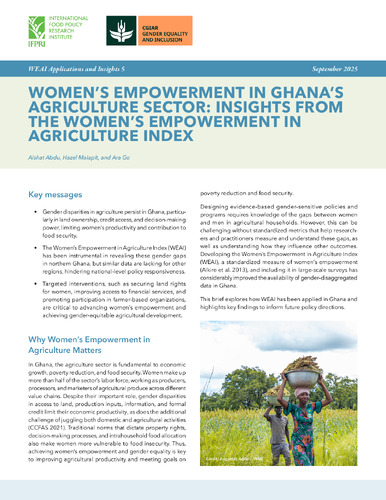
Brief
Women's empowerment in Ghana's agriculture sector: Insights from the Women's Empowerment in Agriculture Index
2025Abdu, Aishat; Malapit, Hazel J.; Go, Ara

Working Paper
Women’s control over income and household spending decisions: A rapid review
2025Eissler, Sarah; Bryan, Elizabeth
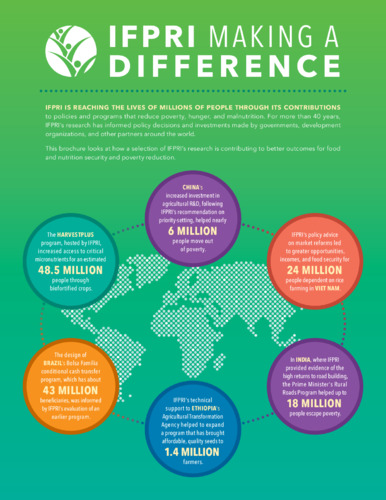
Brochure
IFPRI Making a difference
2025International Food Policy Research Institute
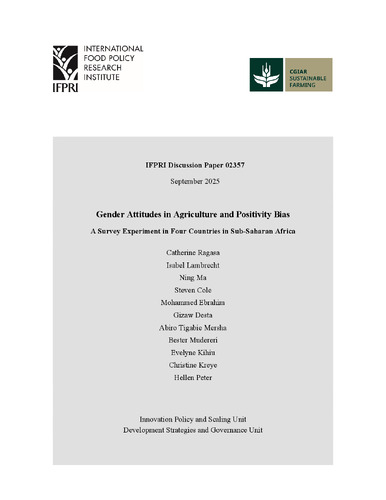
Working Paper
Gender attitudes in agriculture and positivity bias: A survey experiment in four countries in Sub-Saharan Africa
2025
...more
Peter, Hellen

Internal Document
2024 IFPRI A-133 (Uniform guide)
2025International Food Policy Research Institute
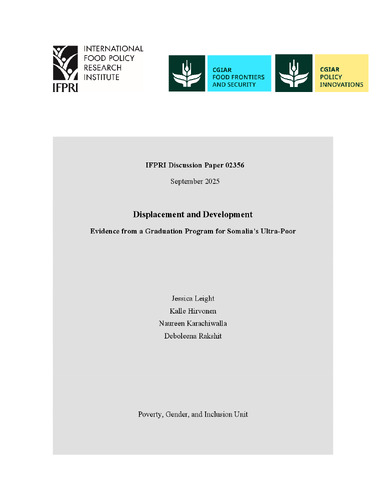
Working Paper
Displacement and development: Evidence from a graduation program for Somalia’s ultra-poor
2025Leight, Jessica; Hirvonen, Kalle; Karachiwalla, Naureen; Rakshit, Deboleena
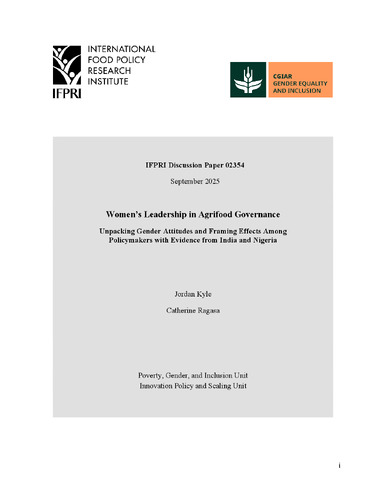
Working Paper
Women’s leadership in agrifood governance: Unpacking gender attitudes and framing effects among policymakers with evidence from India and Nigeria
2025Kyle, Jordan; Ragasa, Catherine
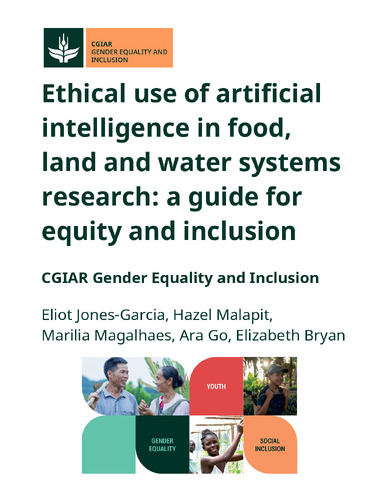
Training Material
Ethical use of artificial intelligence in food, land and water systems research: A guide for equity and inclusion
2025Jones-Garcia, Eliot; Malapit, Hazel J.; Magalhaes, Marilia; Go, Ara; Bryan, Elizabeth

Report
External assessment of outcomes from IFPRI’s causal impact evaluation research 2012–2022
2025Lowder, Sarah K.
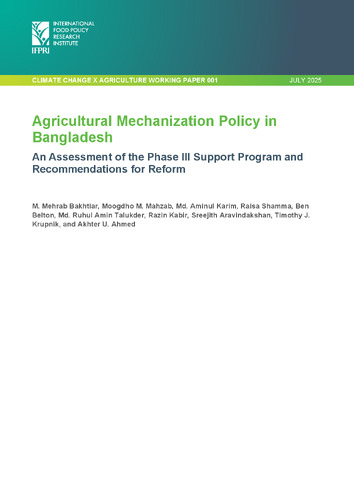
Working Paper
Agricultural mechanization policy in Bangladesh: An assessment of the phase III support program and recommendations for reform
2025Bakhtiar, M. Mehrab; Mahzab, Moogdho; Karim, Md. Aminul; Shamma, Raisa; Belton, Ben; Talukder, Md. Ruhul Amin; Kabir, Razin; Aravindakshan, Sreejith; Krupnik, Timothy J.; Ahmed, Akhter
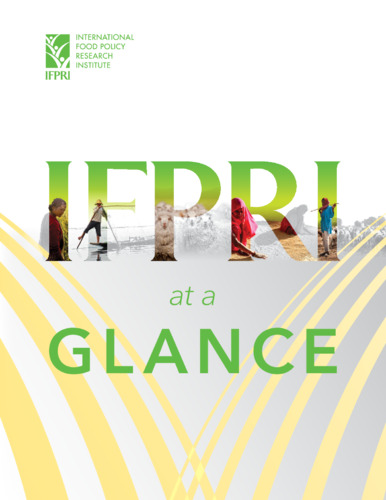
Brochure
IFPRI at a glance
2025International Food Policy Research Institute
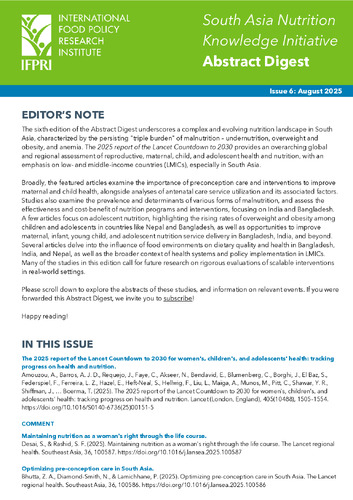
Abstract
South Asia Nutrition Knowledge Initiative: Abstract digest August 2025
2025International Food Policy Research Institute
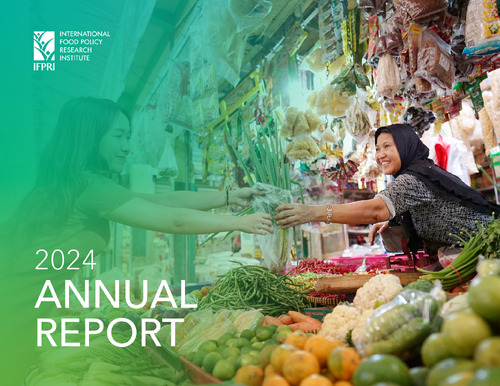
Report
2024 IFPRI annual report
2025International Food Policy Research Institute
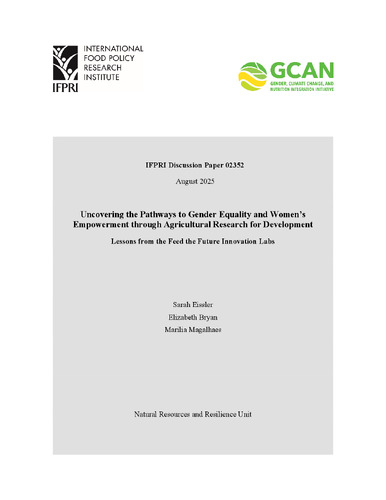
Working Paper
Uncovering the pathways to gender equality and women’s empowerment through agricultural research for development: Lessons from the Feed the Future innovation labs
2025Eissler, Sarah; Bryan, Elizabeth; Magalhaes, Marilia
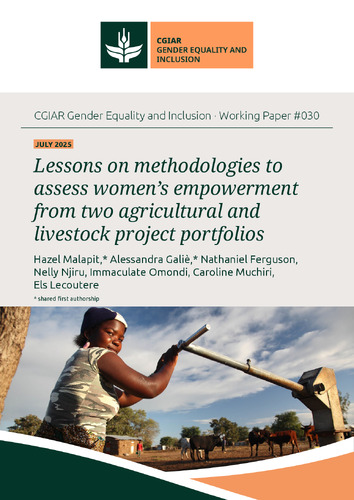
Working Paper
Lessons on methodologies to assess women’s empowerment from two agricultural and livestock project portfolios
2025Malapit, Hazel J.; Galiè, Alessandra; Ferguson, Nathaniel; Njiru, Nelly; Omondi, Immaculate A.; Muchiri, Caroline; Lecoutere, Els
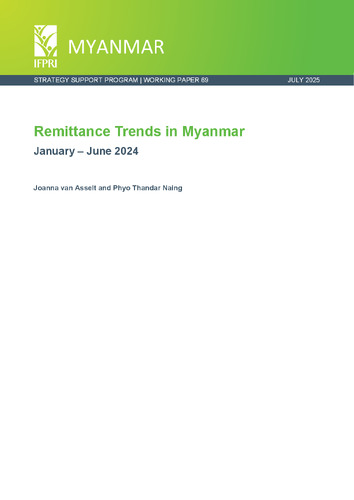
Working Paper
Remittance trends in Myanmar: January - June 2024
2025van Asselt, Joanna; Naing, Phyo Thandar

Working Paper
Kisan credit card and smallholder farmers’ economic performance in eastern India: A panel data analysis
2025Sharma, Kriti; Kumar, Anjani; Agrawal, R.C.

Brief
Applying an integrated engagement model to support country-led food systems transformation: Insights from the SHiFT Initiative's approach in Viet Nam, Ethiopia, and Bangladesh
2025Honeycutt, Sydney; Wyatt, Amanda; Lundy, Mark; Brouwer, Inge D.

Working Paper
Development readiness
2025Omamo, Steven Were

Working Paper
Developing a regional cooperation strategy for scaling up climate-smart agriculture in South Asia
2025Sawhney, Aparna; Sma, Abdelkarim; Pradhan, Mamata; Kamar, Abul; Roy, Devesh

Book Chapter
What do we know about the future of agrifood systems in Southeast Asia?
2025Tran, Nhuong; Valera, Harold Glenn; Chan, Chin Yee; Pede, Valerien Olivier; Aung, Yee Mon; Antonio, Ronald Jeremy

Book Chapter
What do we know about the future of gender equality in relation to food systems?
2025Bryan, Elizabeth; Magalhaes, Marilia; Puskur, Ranjitha; Haan, Nicoline C. de; Lecoutere, Els; Malapit, Hazel J.
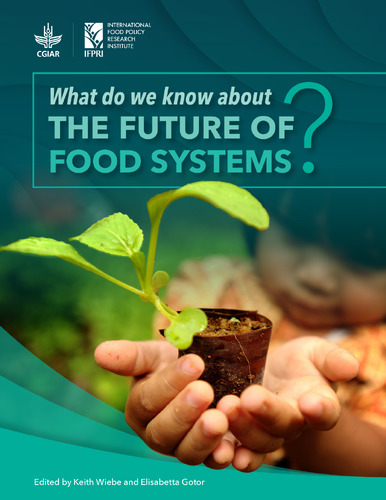
Book
What do we know about the future of food systems?
2025Wiebe, Keith D.; Gotor, Elisabetta
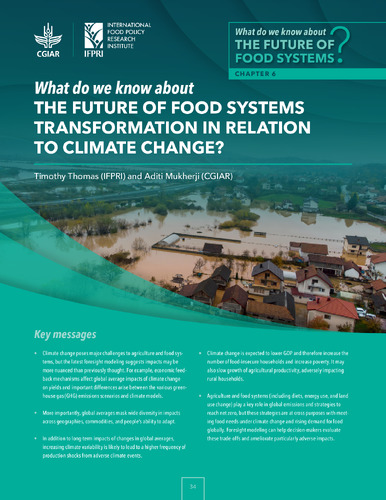
Book Chapter
What do we know about the future of food systems in relation to climate change?
2025Thomas, Timothy S.; Mukherji, Aditi
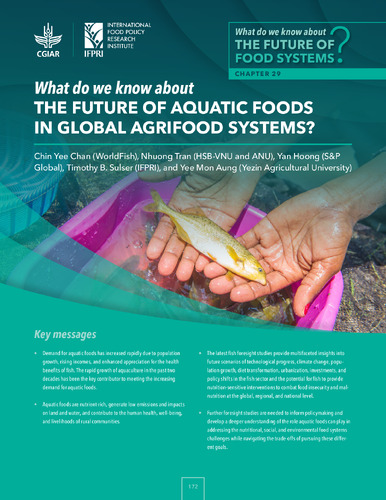
Book Chapter
What do we know about the future of aquatic foods in global agrifood systems?
2025Chan, Chin Yee; Tran, Nhuong; Hoong, Yan; Sulser, Timothy B.; Aung, Yee Mon
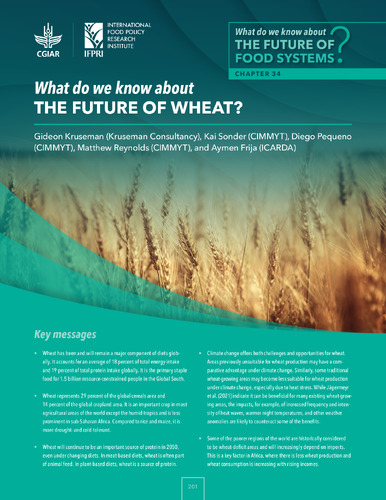
Book Chapter
What do we know about the future of wheat?
2025Kruseman, Gideon; Sonder, Kai; Pequeno, Diego; Reynolds, Matthew; Frija, Aymen
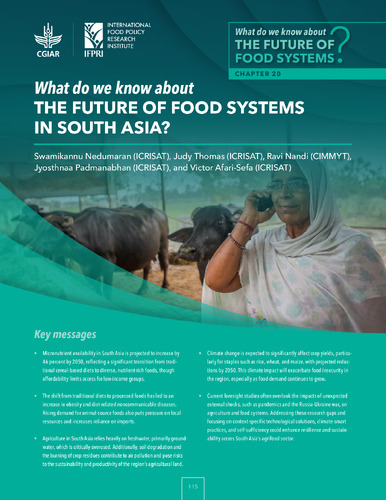
Book Chapter
What do we know about the future of food systems in South Asia?
2025Nedumaran, Swamikannu; Thomas, Judy; Nandi, Ravi; Padmanabhan, Jyosthnaa; Afari-Sefa, Victor
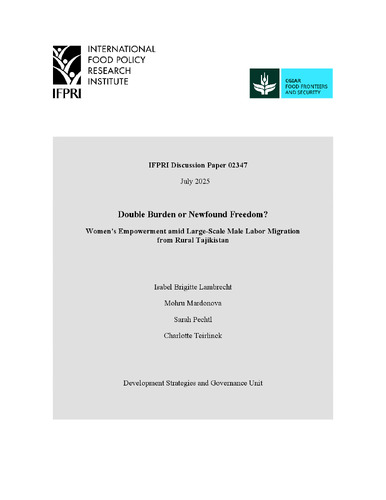
Working Paper
Double burden or Newfound freedom? Women’s empowerment amid large-scale male labor migration from rural Tajikistan
2025Lambrecht, Isabel B.; Mardonova Tolibkhonovna, Mohru; Pechtl, Sarah; Teirlinck, Charlotte
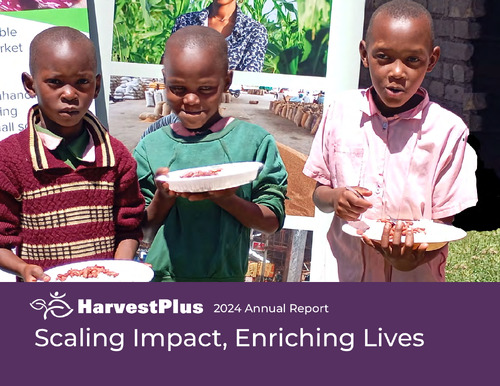
Report
Scaling impact, enriching lives: HarvestPlus 2024 annual report
2025HarvestPlus
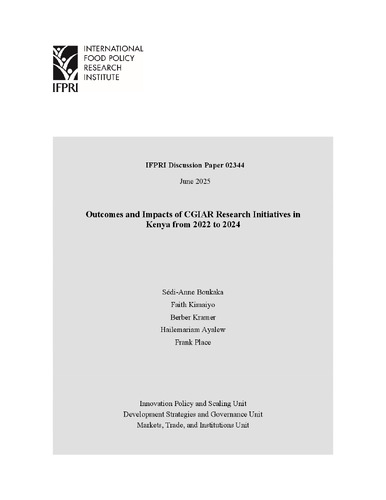
Working Paper
Outcomes and impacts of CGIAR Research Initiatives in Kenya from 2022 to 2024
2025Boukaka, Sedi Anne; Kimaiyo, Faith; Kramer, Berber; Ayalew, Hailemariam; Place, Frank
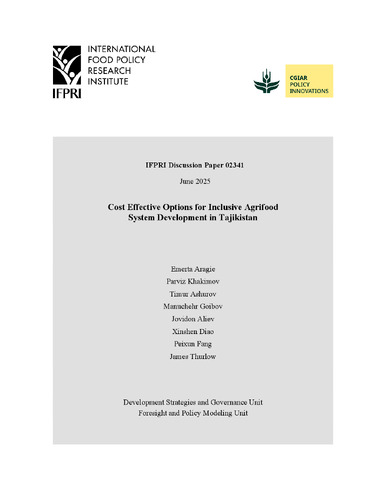
Working Paper
Cost effective options for inclusive agrifood system development in Tajikistan
2025Aragie, Emerta A.; Khakimov, Parviz; Ashurov, Timur; Goibov, Manuchehr; Aliev, Jovidon; Diao, Xinshen; Fang, Peixun; Thurlow, James
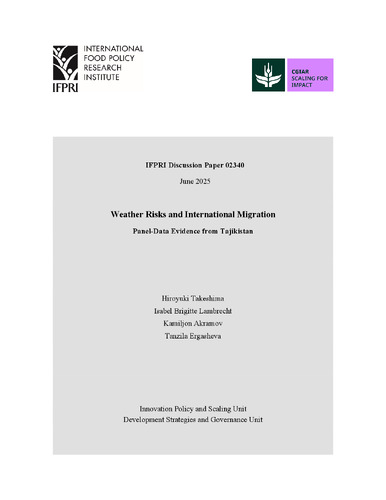
Working Paper
Weather risks and international migration: Panel-data evidence from Tajikistan
2025Takeshima, Hiroyuki; Lambrecht, Isabel B.; Akramov, Kamiljon T.; Ergasheva, Tanzila
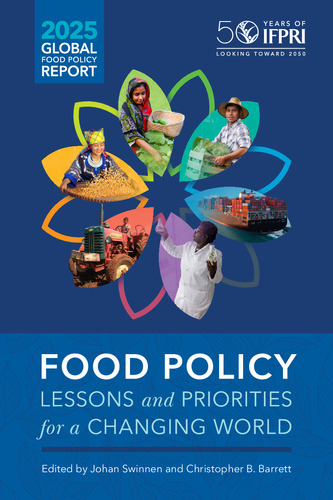
Book
Global food policy report 2025: Food policy: Lessons and priorities for a changing world
2025Swinnen, Johan; Barrett, Christopher B.
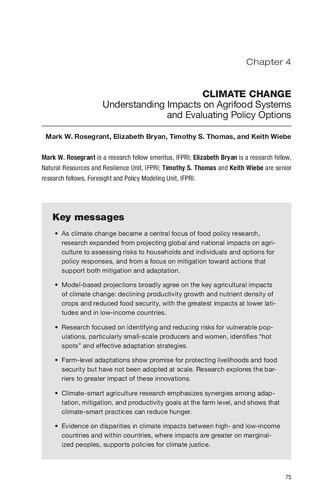
Book Chapter
Climate change: Understanding impacts on agrifood systems and evaluating policy options
2025Rosegrant, Mark W.; Bryan, Elizabeth; Thomas, Timothy S.; Wiebe, Keith D.
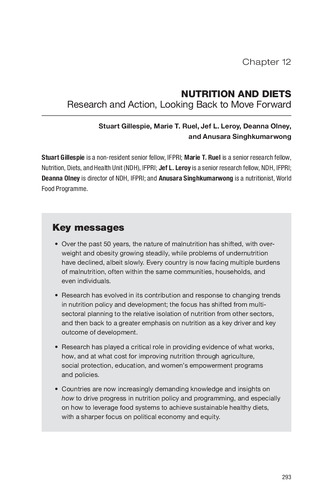
Book Chapter
Nutrition and diets: Research and action, looking back to move forward
2025Gillespie, Stuart; Ruel, Marie T.; Leroy, Jef L.; Olney, Deanna K.; Singhkumarwong, Anusara
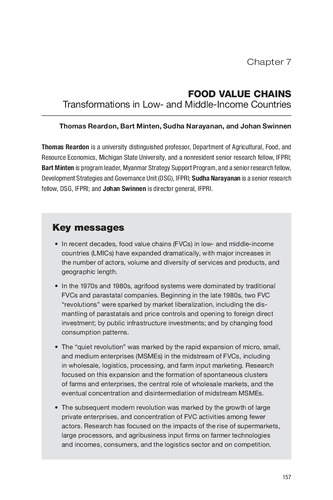
Book Chapter
Food value chains: Transformations in low- and middle-income countries
2025Reardon, Thomas; Minten, Bart; Narayanan, Sudha; Swinnen, Johan
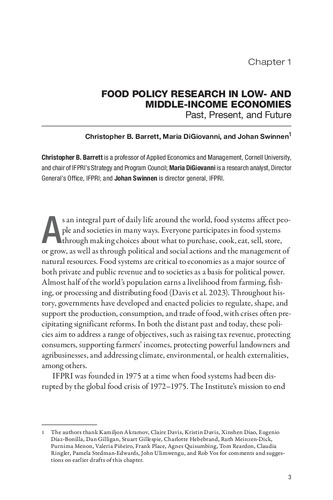
Book Chapter
Food policy research in low- and middle-income economies: Past, present, and future
2025Barrett, Christopher B.; DiGiovanni, Maria; Swinnen, Johan
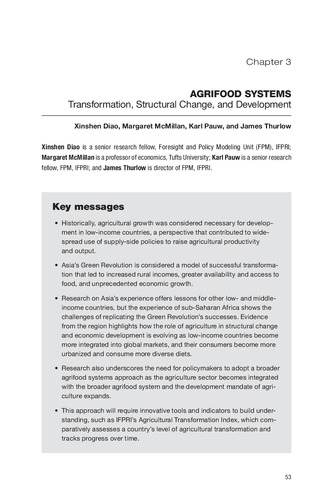
Book Chapter
Agrifood systems: Transformation, structural change, and development
2025Diao, Xinshen; McMillan, Margaret S.; Pauw, Karl; Thurlow, James
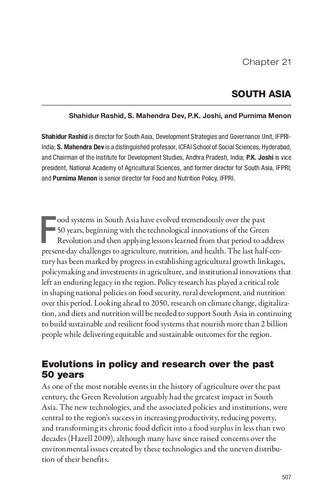
Book Chapter
Regional developments: South Asia [in 2025 GFPR]
2025Rashid, Shahidur; Dev, S. Mahendra; Joshi, Pramod Kumar; Menon, Purnima
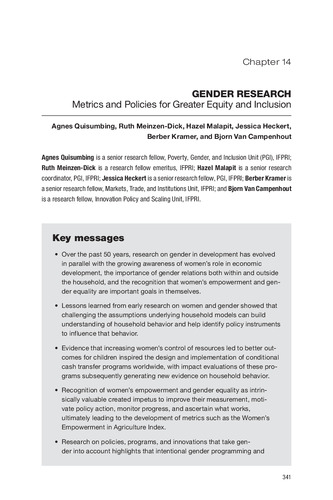
Book Chapter
Gender research: Metrics and policies for greater equity and inclusion
2025Quisumbing, Agnes R.; Meinzen-Dick, Ruth S.; Malapit, Hazel J.; Heckert, Jessica; Kramer, Berber; Van Campenhout, Bjorn

Book Chapter
Environmental sustainability: The intersection of agrifood systems with ecosystem health
2025Ringler, Claudia; Zhang, Wei; Nkonya, Ephraim M.; Wyckhuys, Kris A.G.; Rakotonarivo, O. Sarobidy; Meinzen-Dick, Ruth S.
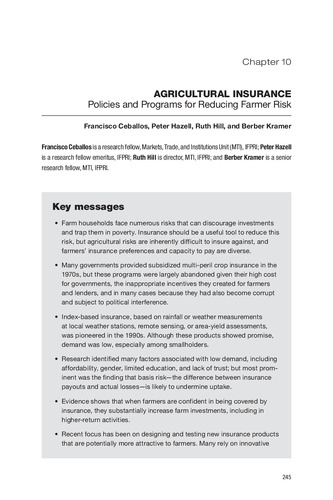
Book Chapter
Agricultural insurance: Policies and programs for reducing farmer risk
2025Ceballos, Francisco; Hazell, Peter B. R.; Hill, Ruth Vargas; Kramer, Berber
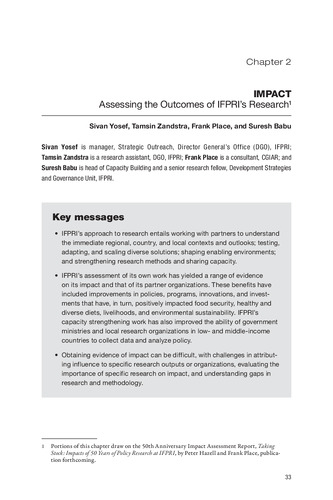
Book Chapter
Impact: Assessing the outcomes of IFPRI's research
2025Yosef, Sivan; Zandstra, Tamsin; Place, Frank; Babu, Suresh Chandra
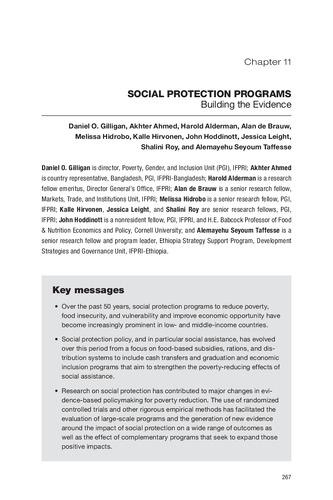
Book Chapter
Social protection programs: Building the evidence and defining priorities
2025Gilligan, Daniel O.; Ahmed, Akhter; Alderman, Harold; de Brauw, Alan; Hidrobo, Melissa; Hirvonen, Kalle; Hoddinott, John F.; Leight, Jessica; Roy, Shalini; Taffesse, Alemayehu Seyoum
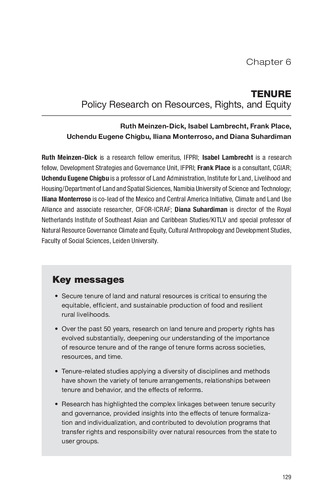
Book Chapter
Tenure: Policy research on resources, rights, and equity
2025Meinzen-Dick, Ruth S.; Lambrecht, Isabel B.; Place, Frank; Chigbu, Uchendu Eugene; Monterroso, Iliana; Suhardiman, Diana
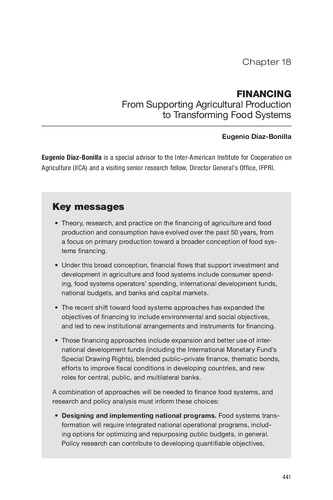
Book Chapter
Financing: From supporting agricultural production to transforming food systems
2025Díaz-Bonilla, Eugenio
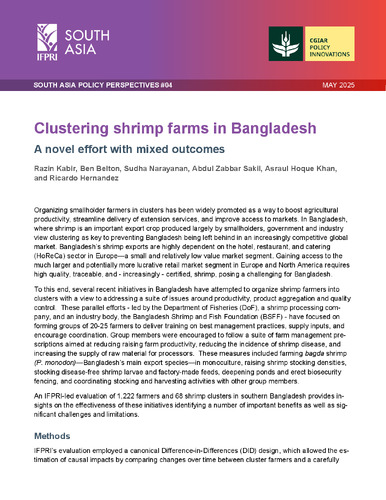
Brief
Clustering shrimp farms in Bangladesh: A novel effort with mixed outcomes
2025Kabir, Razin; Belton, Ben; Narayanan, Sudha; Sakil, Abdul Zabbar; Khan, Asraul Hoque; Hernandez, Ricardo
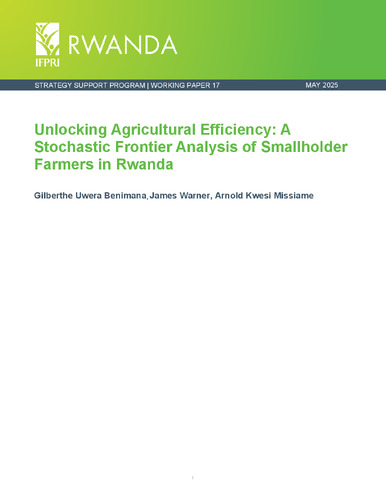
Working Paper
Unlocking agricultural efficiency: A stochastic frontier analysis of smallholder farmers in Rwanda
2025Benimana, Gilberthe Uwera; Warner, James; Missiame, Arnold Kwesi
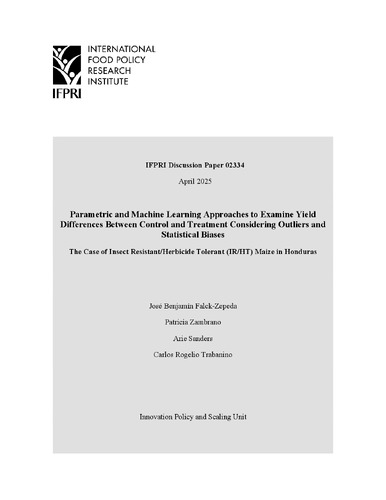
Working Paper
Parametric and machine learning approaches to examine yield differences between control and treatment considering outliers and statistical biases: The case of insect resistant/herbicide tolerant (IR/HT) maize in Honduras
2025Falck-Zepeda, José B.; Zambrano, Patricia; Sanders, Arie; Trabanino, Carlos Rogelio
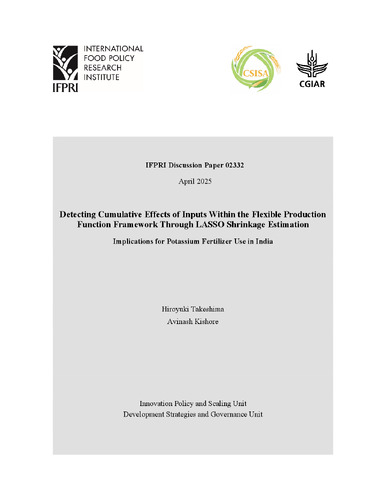
Working Paper
Detecting cumulative effects of inputs within the flexible production function framework through LASSO shrinkage estimation: Implications for potassium fertilizer use in India
2025Takeshima, Hiroyuki; Kishore, Avinash
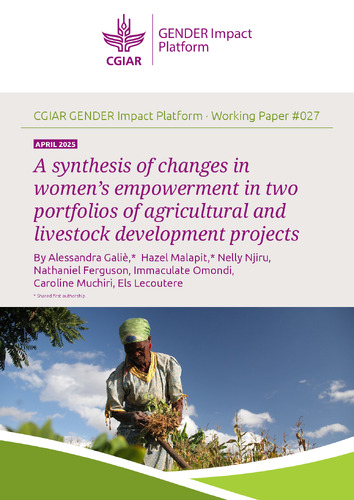
Working Paper
A synthesis of changes in women's empowerment in two portfolios of agricultural and livestock development projects
2025Galiè, Alessandra; Malapit, Hazel J.; Njiru, Nelly; Ferguson, Nathaniel; Omondi, Immaculate A.; Muchiri, Caroline; Lecoutere, Els

Working Paper
Gender integration in food-system policies: an adapted policy assessment framework
2025Mawia, Harriet; Muchiri, Caroline; Frimpong-Wiafe, Belinda; Enahoro, Dolapo K.
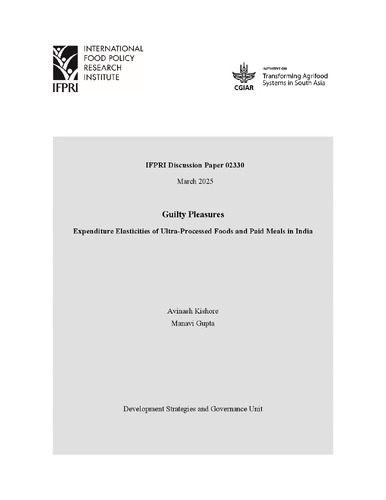
Working Paper
Guilty pleasures: Expenditure elasticities of ultra-processed foods and paid meals in India
2025Gupta, Manavi; Kishore, Avinash
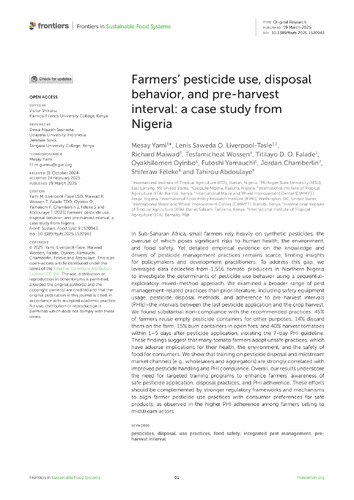
Journal Article
Farmers' pesticide use, disposal behavior, and pre-harvest interval: A case study from Nigeria
2025Gurmui, Mesay Yami; Liverpool-Tasie, Lenis Saweda O.; Richards, Maiwada; Wossen, Tesfamicheal; Falade, Titilayo; Oyinbo, Oyakhilomen; Yamauchi, Futoshi; Chamberlin, Jordan; Feleke, Shiferaw; Abdoulaye, Tahirou
1 to
20
of 100
RELATED NEWS/EVENTS

Publication – Food Transfers, Cash Transfers, Behavior Change Communication and Child Nutrition: Evidence from Bangladesh

Blog – Informing policies with causal impact evaluations: Co-creation and trust matter

New Publication – Transfers, nutrition programming, and economic well-being: Experimental evidence from Bangladesh

Publication – Comparing delivery channels to promote nutrition-sensitive agriculture: A cluster-randomized controlled trial in Bangladesh
